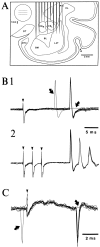Reciprocal changes in the firing probability of lateral and central medial amygdala neurons
- PMID: 9880603
- PMCID: PMC6782219
- DOI: 10.1523/JNEUROSCI.19-02-00836.1999
Reciprocal changes in the firing probability of lateral and central medial amygdala neurons
Erratum in
- J Neurosci 1999 Apr 1;19(7):2841
Abstract
The amygdala is essential for classical fear conditioning. According to the current model of auditory fear conditioning, the lateral nucleus is the input station of the amygdala for conditioned auditory stimuli, whereas the central nucleus is the output station for conditioned fear responses. Yet, the lateral nucleus does not project to the central medial nucleus, where most brainstem projections of the amygdala originate. The available evidence suggests that the basal nuclei could transmit information from the lateral to the central medial nucleus. However, interposed between the basolateral complex and the central nucleus are clusters of GABAergic cells, the intercalated neurons, which receive inputs from the lateral and basal nuclei and contribute a massive projection to the central medial nucleus. Because it is impossible to predict the consequences of these connections, we correlated the spontaneous and auditory-evoked activity of multiple simultaneously recorded neurons of the lateral, basal, and central nuclei. The spontaneous activity of lateral and basolateral neurons was positively correlated to that of central lateral cells but negatively correlated to that of central medial neurons. In response to auditory stimuli, the firing probability of lateral and central medial neurons oscillated in phase opposition, initially being excited and inhibited, respectively. In light of previous anatomical findings, we propose that the lateral nucleus exerts two indirect actions on central medial neurons: an excitation via the basal nuclei and an inhibition via intercalated neurons.
Figures






References
-
- Bordi F, LeDoux J, Clugnet MC, Pavlides C. Single-unit activity in the lateral nucleus of the amygdala and overlying areas of the striatum in freely behaving rats: rates, discharge patterns, and responses to acoustic stimuli. Behav Neurosci. 1993;107:757–769. - PubMed
-
- Chapman PF, Kairiss EW, Keenan CL, Brown TH. Long-term synaptic potentiation in the amygdala. Synapse. 1990;11:310–318. - PubMed
-
- Davis M. The role of the amygdala in fear and anxiety. Annu Rev Neurosci. 1992;15:353–373. - PubMed
-
- Francis J, Hernandez LL, Powell DA. Lateral hypothalamic lesions: effects on pavlovian cardiac and eyeblink conditioning in the rabbit. Brain Res Bull. 1981;6:155–163. - PubMed
Publication types
MeSH terms
Substances
LinkOut - more resources
Full Text Sources
